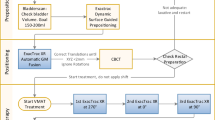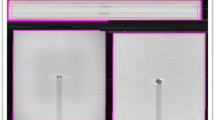Abstract
Purpose:
To evaluate the residual errors and required safety margins after stereoscopic kilovoltage (kV) X-ray target localization of the prostate in image-guided radiotherapy (IGRT) using internal fiducials.
Patients and Methods:
Radiopaque fiducial markers (FMs) have been inserted into the prostate in a cohort of 33 patients. The ExacTrac/Novalis Body™ X-ray 6d image acquisition system (BrainLAB AG, Feldkirchen, Germany) was used. Corrections were performed in left-right (LR), anterior-posterior (AP), and superior-inferior (SI) direction. Rotational errors around LR (x-axis), AP (y) and SI (z) have been recorded for the first series of nine patients, and since 2007 for the subsequent 24 patients in addition corrected in each fraction by using the Robotic Tilt Module™ and Varian Exact Couch™. After positioning, a second set of X-ray images was acquired for verification purposes. Residual errors were registered and again corrected.
Results:
Standard deviations (SD) of residual translational random errors in LR, AP, and SI coordinates were 1.3, 1.7, and 2.2 mm. Residual random rotation errors were found for lateral (around x, tilt), vertical (around y, table), and longitudinal (around z, roll) and of 3.2°, 1.8°, and 1.5°. Planning target volume (PTV)-clinical target volume (CTV) margins were calculated in LR, AP, and SI direction to 2.3, 3.0, and 3.7 mm. After a second repositioning, the margins could be reduced to 1.8, 2.1, and 1.8 mm.
Conclusion:
On the basis of the residual setup error measurements, the margin required after one to two online X-ray corrections for the patients enrolled in this study would be at minimum 2 mm. The contribution of intrafractional motion to residual random errors has to be evaluated.
Zusammenfassung
Ziel:
Der residuale Lagerungsfehler und die erforderlichen Sicherheitsabstande in der bildgestutzten Lokalisation und Positionskorrektur der Prostata sollten ermittelt werden.
Patienten und Methodik:
In einer Gruppe von 33 Patienten wurden rontgendichte Marker in die Prostata implantiert. Die Autoren setzten das rontgenbasierte und automatisierte Positionierungs- und Verifikationssystem ExacTrac/Novalis Body™ (BrainLAB AG, Feldkirchen) ein. Fur die erste Serie von neun Patienten erfolgten tagliche Korrekturen des initalen Translationsfehlers in mediolateraler (ML), anteroposteriorer (AP) und superoinferiorer (SI) Richtung. Rotationsfehler um die seitliche (x), vertikale (y) und longitudinale Achse (z) wurden aufgezeichnet und seit 2007 fur die ubrigen 24 Patienten unter Verwendung des Robotic Tilt Module™ und der Varian Exact Couch™ vor jeder Fraktion ausgeglichen. Nach der Positionierung erfolgte eine Verifikation der Patientenposition mittels stereoskopischer Rontgenkontrollaufnahmen. Noch bestehende residuale Fehler wurden aufgezeichnet und erneut winkelgetreu korrigiert.
Ergebnisse:
Der residuale translationale Fehler betrug in LR, AP und SI (1 Standardabweichung [SD]) 1,3, 1,7 und 2,2 mm. Ermittelt wurden residuale Rotationsfehler (1 SD) um x, y und z von 3,2°, 1,8° und 1,5°. Die erforderlichen Sicherheitsabstande zwischen klinischem Zielvolumen (CTV) und Planungszielvolumen (PTV) wurden in ML, AP und SI mit 2,3, 3,0 und 3,7 mm berechnet. Nach einem zweiten Korrekturschritt konnten diese Sicherheitsabstande auf 1,8, 2,1 und 1,8 mm verringert werden.
Schlussfolgerung:
Auf der Grundlage der nach ein (oder zwei) Lagerungskorrekturen verbleibenden Restfehler der Patienten dieser Studie ist fur das PTV ein Sicherheitsabstand von mindestens 2 mm zum CTV erforderlich. Der Beitrag der intrafraktionellen Bewegung der Prostata fur den Lokalisationsfehler verbleibt das Thema weiterer Untersuchungen.
Similar content being viewed by others
References
Alonso-Arrizabalaga S, Brualla Gonzalez L, Rosello Ferrando JV, et al. Prostate planning treatment volume margin calculation based on the ExacTrac X-Ray 6D image-guided system: margins for various clinical implementations. Int J Radiat Oncol Biol Phys 2007;69:936–43
Aubry JF, Beaulieu L, Girouard LM, et al. Measurements of intrafraction motion and interfraction and intrafraction rotation of prostate by three-dimensional analysis of daily portal imaging with radiopaque markers. Int J Radiat Oncol Biol Phys 2004;60:30–9
Beaulieu L, Girouard LM, Aubin S, et al. Performing daily prostate targeting with a standard V-EPID and an automated radio-opaque marker detection algorithm. Radiother Oncol 2004;73:61–4
Boda-Heggemann, Kohler FM, Wertz H, et al. Intrafraction motion of the prostate during an IMRT session: a fiducial-based 3D measurement with cone-beam CT. Radiat Oncol 2008;3:37
Chung PW, Haycocks T, Brown T, et al. On-line aSi portal imaging of implanted fiducial markers for the reduction of interfraction error during conformal radiotherapy of prostate carcinoma. Int J Radiat Oncol Biol Phys 2004;60:329–34
Cosgrove VP, Jahn U, Pfaender M, et al. Commissioning of a micro multi-leaf collimator and planning system for stereotactic radiosurgery. Radiother Oncol 1999;50:325–36
De Boer HC, van Os MJ, Jansen PP, Heijmen BJ. Application of the No Action Level (NAL) protocol to correct for prostate motion based on electronic portal imaging of implanted markers. Int J Radiat Oncol Biol Phys 2005;61:969–83
Eng TY, Luh JY, Thomas CR Jr. The efficacy of conventional external beam, three-dimensional conformal, intensity-modulated, particle beam radiation, and brachytherapy for localized prostate cancer. Curr Urol Rep 2005;6:194–209
Enmark M, Korreman S, Nystrom H. IGRT of prostate cancer: is the margin reduction gained from daily IG time-dependent? Acta Oncol 2006;45:907–14
Fu W, Yang Y, Li X, et al. Dosimetric effects of patient rotational setup errors on prostate IMRT treatments. Phys Med Biol 2006;51:5321–31
Ghadjar P, Gwerder N, Madlung A, et al. Use of gold markers for setup in image-guided fractionated high-dose-rate brachytherapy as a monotherapy for prostate cancer. Strahlenther Onkol 2009;185:731–5
Ghilezan M, Jaffray D, Siewerdsen J, et al. Prostate gland motion assessed with cine magnetic resonance imaging (cine-MRI). Int J Radiat Oncol Biol Phys 2005;62:406–17
Graf R, Wust P, Budach V, Bohmer D. Potentials of on-line repositioning based on implanted fiducial markers and electronic portal imaging in prostate cancer radiotherapy. Radiat Oncol 2009;4:13
Henry AM, Wilkinson C, Wylie JP, et al. Trans-perineal implantation of radio-opaque treatment verification markers into the prostate: an assessment of procedure related morbidity, patient acceptability and accuracy. Radiother Oncol 2004;73:57–9
International Commission on Radiation Units and Measurements. Prescribing, recording and reporting photon beam therapy. ICRU report 50. Bethesda: International Commission on Radiation Units and Measurements, 1993
Kalz J, Sterzing F, Schubert K, et al. Dosimetric comparison of image guidance by megavoltage computed tomography versus bone alignment for prostate cancer radiotherapy. Strahlenther Onkol 2009;185:241–7
Kotte AN, Hofman P, Lagendijk JJW, et al. Intrafraction motion of the prostate during external-beam radiation therapy: analysis of 427 patients with implanted fiducial markers. Int J Radiat Oncol Biol Phys 2007; 69:419–25
Kupelian PA, Lee C, Langen KM, et al. Evaluation of image-guidance strategies in the treatment of localized prostate cancer. Int J Radiat Oncol Biol Phys 2008;70:1151–7
Kupelian PA, Willoughby TR, Meeks SL, et al. Intraprostatic fiducials for localization of the prostate gland: monitoring intermarker distances during radiation therapy to test for marker stability. Int J Radiat Oncol Biol Phys 2005;62:1291–6
Langen KM, Zhang Y, Andrews RD, et al. Initial experience with megavoltage (MV) CT guidance for daily prostate alignments. Int J Radiat Oncol Biol Phys 2005;62:1517–24
Lauve AD, Siebers JV, Crimaldi AJ, et al. A dynamic compensation strategy to correct patient-positioning errors in conformal prostate radiotherapy. Med Phys 2006;33:1879–87
Letourneau D, Martinez AA, Lockman D, et al. Assessment of residual error for online cone-beam CT-guided treatment of prostate cancer patients. Int J Radiat Oncol Biol Phys 2005;62:1239–46
Linthout N, Verellen D, Tournel K, et al. Assessment of secondary patient motion induced by automated couch movement during on-line 6 dimensional repositioning in prostate cancer treatment. Radiother Oncol 2007;83:168–74
Litzenberg DW, Balter JM, Hadley SW, et al.Influence of intrafraction motion on margins for prostate radiotherapy. Int J Radiat Oncol Biol Phys 2006;65:548–53
McNair HA, Hansen VN, Parker CC, et al. A comparison of the use of bony anatomy and internal markers for offline verification and an evaluation of the potential benefit of online and offline verification protocols for prostate radiotherapy. Int J Radiat Oncol Biol Phys 2008;71:41–50
Nairz O, Merz F, Deutschmann H, et al. A strategy for the use of image-guided radiotherapy (IGRT) on linear accelerators and its impact on treatment margins for prostate cancer patients. Strahlenther Onkol 2008;184: 663–7
Noel C, Parikh PJ, Roy M, et al. Prediction of intrafraction prostate motion: accuracy of pre- and post-treatment imaging and intermittent imaging. Int J Radiat Oncol Biol Phys 2009;73:692–8
Pinkawa M, Pursch-Lee M, Asadpour B, et al. Image-guided radiotherapy of prostate cancer. Strahlenther Onkol 2008;184:679–85
Polat B, Guenther I, Wilbert J, et al. Intrafractional uncertainties in image- guided intensity-modulated radiotherapy (IMRT) of prostate cancer. Strahlenther Onkol 2008;184:668–73
Poli ME, Parker W, Patrocinio H, et al. An assessment of PTV margin definitions for patients undergoing conformal 3D external beam radiation therapy for prostate cancer based on an analysis of 10,327 pretreatment daily ultrasound locations. Int J Radiat Oncol Biol Phys 2007;67:1430–7
Poulsen PR, Muren LP, Hoyer M. Residual set-up errors and margins in on-line image-guided prostate localization in radiotherapy. Radiother Oncol 2007;85:201–6
Remeijer P, Geerlof E, Ploeger L, et al. 3-D portal image analysis in clinical practice: an evaluation of 2-D and 3-D analysis techniques as applied to 30 prostate cancer patients. Int J Radiat Oncol Biol Phys 2000;46:1281–90
Rijkhorst EJ, van Herk M, Lebesque JV, Sonke JJ. Strategy for online correction of rotational organ motion for intensity-modulated radiotherapy of prostate cancer. Int J Radiat Oncol Biol Phys 2007;69:1608–17
Scarbrough TJ, Golden NM, Ting JY, et al. Comparison of ultrasound and implanted seed marker prostate localization methods: implications for image-guided radiotherapy. Int J Radiat Oncol Biol Phys 2006; 65:378–87
Schallenkamp JM, Herman MG, Kruse JJ, Pisansky TM. Prostate position relative to pelvic bony anatomy based on intraprostatic gold markers and electronic portal imaging. Int J Radiat Oncol Biol Phys 2005;63: 800–11
Soete G, Van de Steene J, Verellen D, et al. Initial clinical experience with infrared reflecting skin markers in the positioning of patients treated by conformal radiotherapy for prostate cancer. Int J Radiat Oncol Biol Phys 2002;52:694–8
Soete G, Verellen D, Michielsen D, et al. Clinical use of stereoscopic X-ray positioning of patients treated with conformal radiotherapy for prostate cancer. Int J Radiat Oncol Biol Phys 2002;54:948–52
Soete G, Verellen D, Tournel K, Storme G. Setup accuracy of stereoscopic X-ray positioning with automated correction for rotational errors in patients treated with conformal arc radiotherapy for prostate cancer. Radiother Oncol 2006;80:371–3
Tsai CL, Wu JK, Wang CW, et al. Using cone-beam computed tomography to evaluate the impact of bladder filling status on target position in prostate radiotherapy. Strahlenther Onkol 2009;185:588–95
Van den Heuvel F, Fugazzi J, Seppi E, Forman JD. Clinical application of a repositioning scheme, using gold markers and electronic portal imaging. Radiother Oncol 2006;79:94–100
Van Herk M, Bruce A, Kroes G, et al. Quantification of organ motion during conformal radiotherapy of the prostate by three dimensional image registration. Int J Radiat Oncol Biol Phys 1995;33:1311–20
Van Herk M, Remeijer P, Lebesque JV. Inclusion of geometric uncertainties in treatment plan evaluation. Int J Radiat Oncol Biol Phys 2002;52:1407–22
Van Herk M, Remeijer P, Rasch, C, Lebesque JV. The probability of correct target dosage: dose-population histograms for deriving treatment margins in radiotherapy. Int J Radiat Oncol Biol Phys 2000;47:1121–35
Van Herten YR, van de Kamer JB, van Wieringen N, et al. Dosimetric evaluation of prostate rotations and their correction by couch rotations. Radiother Oncol 2008;88:156–62
Verellen D, Soete G, Linthout N, et al. Quality assurance of a system for improved target localization and patient setup that combines realtime infrared tracking and stereoscopic X-ray imaging. Radiother Oncol 2003;67:129–41
Wertz H, Lohr F, Dobler B, et al. Dosimetric impact of image-guided translational isocenter correction for 3-D conformal radiotherapy of the prostate. Strahlenther Onkol 2007;183:203–10
Wu J, Haycocks T, Alasti H, et al. Positioning errors and prostate motion during conformal prostate radiotherapy using on-line isocentre set-up verification and implanted prostate markers. Radiother Oncol 2001; 61:127–33
Yan H, Yin F, Kim J. A phantom study on the positioning accuracy of the Novalis Body System. Med Phys 2003;30:3052–60
Author information
Authors and Affiliations
Corresponding author
Rights and permissions
About this article
Cite this article
Graf, R., Boehmer, D., Budach, V. et al. Residual Translational and Rotational Errors after kV X-Ray Image-Guided Correction of Prostate Location Using Implanted Fiducials. Strahlenther Onkol 186, 544–550 (2010). https://doi.org/10.1007/s00066-010-2030-8
Received:
Accepted:
Published:
Issue Date:
DOI: https://doi.org/10.1007/s00066-010-2030-8




